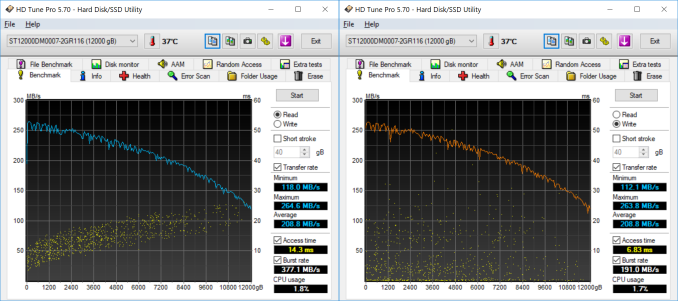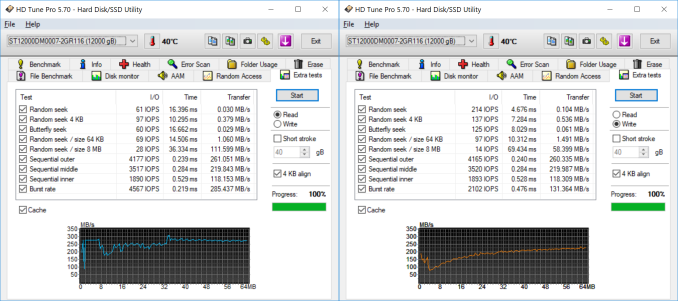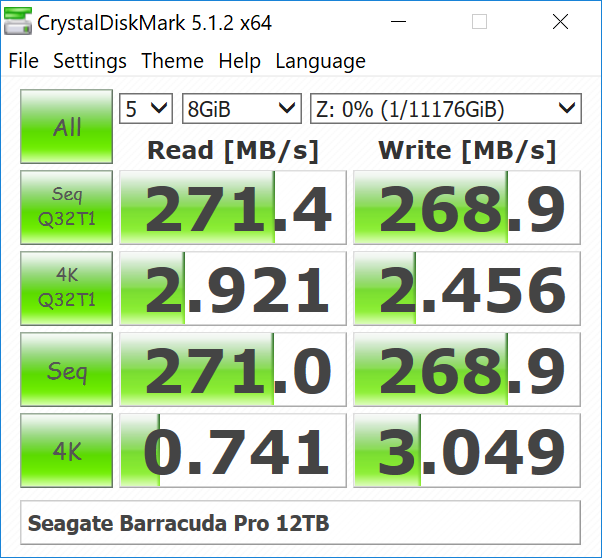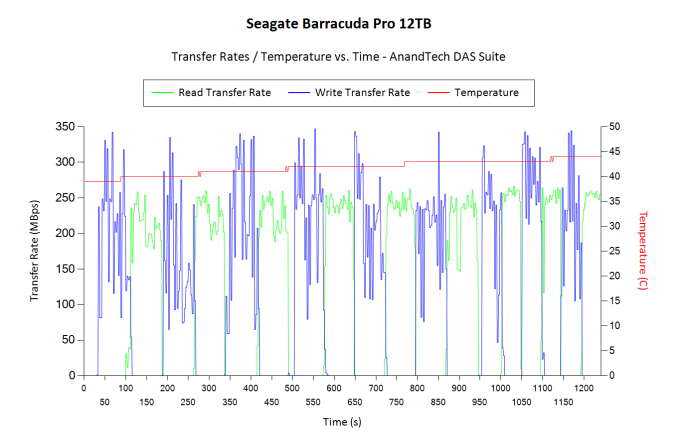Seagate BarraCuda Pro 12TB HDD Review
by Ganesh T S on November 15, 2017 8:00 AM EST- Posted in
- Storage
- Seagate
- HDDs
- Helium HDD
Performance - Internal Storage Mode
The performance of an internal storage device is dependent on the performance characteristics of the device as well as the file system being used. In order to isolate the effects of the latter, we first benchmarked the raw drives using HD Tune Pro 5.70. It was then formatted in NTFS and subject to our standard direct-attached benchmark suite.
Raw Drive Performance
HD Tune Pro allows us to run a variety of tests to determine transfer rates and IOPS for various artificial workloads. In addition, it also allows us to visualize how the performance varies as the tracking head moves from the outer parts of the platter towards the center (i.e, transfer rates as a function of the block address).
Empty drives are bound to perform very well, but, depending on the location of the data in the drive, we find that access rates can go as low as 112 MBps for sequential workloads. Write access times are a bit unpredictable due to the multi-segmented cache.
Random accesses are never the strong points of hard drives, and we see that the BarraCuda Pro delivers around 70 IOPS for 4K random reads and writes.
The extra tests help in putting some numbers to sequential accesses targeting different areas of the drive. It also provides some interesting numbers relevant to various random access workloads.
DAS Benchmarks
Consumers opting for drives such as the 12TB Seagate BarraCuda Pro typically need high-capacity local storage for holding and editing / processing large-sized multimedia files. Prior to taking a look at the real-life benchmarks, we first check what CrystalDiskMark has to report for the drive.
In order to tackle the real-life use-case of transferring large amounts of data back and forth from the drive, we created three test folders with the following characteristics:
- Photos: 15.6 GB collection of 4320 photos (RAW as well as JPEGs) in 61 sub-folders
- Videos: 16.1 GB collection of 244 videos (MP4 as well as MOVs) in 6 sub-folders
- BR: 10.7 GB Blu-ray folder structure of the IDT Benchmark Blu-ray (the same that we use in our robocopy tests for NAS systems)
| Seagate BarraCuda Pro 12TB robocopy Benchmarks (MBps) | ||
| Write Bandwidth | Read Bandwidth | |
| Photos | 219.23 | 205.51 |
| Videos | 231.42 | 219.46 |
| Blu-ray Folder | 234.05 | 230.02 |
These numbers are consistently around 15 - 20 MBps more than what we obtained for the 10TB drives last year.
While processing our DAS suite, we also recorded the instantaneous transfer rates and temperature of the drive. Compared to typical disk drives, the write transfers show higher instantaneous speeds due to a combination of the firmware and the 256 MB cache inside the drive. However, sustained write rates are comparable to other high-capacity drives when the cache is exhausted. The temperature of the unit at the end of the transfers (more than 250GB of traffic) rose by less than 5C, pointing to the power-efficiency of the platform.
For the use-case involving editing of multimedia files directly off the disk, we take advantage of PCMark 8's storage benchmark. The storage workload is a good example of a user workload, involving games as well as multimedia editing applications. The command line version allows us to cherry-pick storage traces to run on a target drive. We chose the following traces.
- Adobe Photoshop (Light)
- Adobe Photoshop (Heavy)
- Adobe After Effects
- Adobe Illustrator
Usually, PCMark 8 reports time to complete the trace, but the detailed log report has the read and write bandwidth figures which we present in our performance graphs. Note that the bandwidth number reported in the results don't involve idle time compression. Results might appear low, but that is part of the workload characteristic.
| Seagate BarraCuda Pro 12TB PCMark8 Storage Benchmarks (MBps) | ||
| Write Bandwidth | Read Bandwidth | |
| Adobe Photoshop (Light) | 250.22 | 9.06 |
| Adobe Photoshop (Heavy) | 246.88 | 11.48 |
| Adobe After Effects | 89.74 | 8.85 |
| Adobe Illustrator | 196.38 | 8.42 |
Compared to the results from the 10TB drive last year, we find that the read workloads are slightly worse off, but, the write workloads are much faster.















62 Comments
View All Comments
phoenix_rizzen - Wednesday, November 15, 2017 - link
Go read through some of the quarterly drive reports from Backblaze. The larger sized Seagates are much more reliable than the earlier 1-3 TB drives. Although Toshiba and Hitachi are still the drives to beat for reliability.artk2219 - Wednesday, November 15, 2017 - link
Hey Ganesh, thank you for the review, honestly i'm always surprised by how much faster hard drives are now than they were even 5 years ago. On an unrelated question, how do you like that cooler master case? I've been considering getting one recently for its openness but I wasn't sure about whether or not i could get used to how much horizontal space it takes up on a desk.ganeshts - Wednesday, November 15, 2017 - link
I simply love it, but, I have to let you know that my requirements are not the typical computer builder's requirements.I wanted something that could be used to easily hot-swap hard drives (since I tend to benchmark internal drives quite a bit) - the two front bays serve this purpose well.
I wanted it to be fairly portable - the 'carry handles' on either side have been put to use many times and have worked well.
There is plenty of ventilation, but, to be honest, I am not overclocking, and I don't even have a dGPU in that build. So, I really can't comment on that aspect.
Lastly, I wanted a LAN box rather than a tower because I wanted all the ports to be easily accessible when placed in makeshift 'rackmount' environments. Currently I have it in a repurposed garage shelving unit [ https://www.walmart.com/ip/Edsal-36-W-x-18-D-x-72-... ].
artk2219 - Wednesday, November 15, 2017 - link
Minus the moving those were also my considerations. I'm constantly swapping and playing with different GPU's and CPU's so the ability to just open the top and be there is a big plus. I tend to not keep the exact same config for too much time, and in the time ive had my current corsair carbide 500r, ive gone through 2 motherboards, 4 different cpu's, 5 GPU's, and multiple hard drives. Not to mention all of the parts i've just tested to verify that it works for family and friends. Normally I keep cases for 5 to 7 years or until they've just had enough, but since I saw this case it seemed like it would be perfect for the sort of use I have in mind, especially now that AM4 seems like it'll have quite a few options available to it like AM2+ and AM3+ did, and I'm building up an AM4 build with an Athlon x4 950. I honestly haven't found a good review of one, and its cheap enough for me to just get one to play with while I see whether or not i want to spring for a 1600, 1700, or just wait for the refresh, although it is slower than my FX 8320 @4.4. Thanks for the information though!Liltorp - Thursday, November 16, 2017 - link
All my important data (around 75GByte) I have in 4 copies. One copy on my personal PC, one copy on my home NAS hidden away, one copy in Google Drive and one copy on an external harddisk that I keep at my workplace. Location redundance is important.My less-imprortant data (around 5TByte mainly video material) I have in 2 copy. One copy on my personal PC and one copy on my home NAS.
chrysrobyn - Thursday, November 16, 2017 - link
I find these types of benchmarks far less interesting than the SSD benchmarks Anandtech uses. I know spinners would get blown out of the water by the top end SSDs on The Destroyer, but I do wonder how the fastest spinners would compete with the lowest end SSDs. Spinning media has its place in this world, and I'd really like to see benchmarks that tell that story.b1gtuna - Thursday, November 16, 2017 - link
Would anyone use this without redundancy? It is nice that they throw in 2 years of data recovery as part of the warranty, but I am genuinely curious if the drive technology has matured enough to guarantee safety from data loss.jameskatt - Sunday, November 19, 2017 - link
I hope one of these days 12 TB drives are < $100.Beaver M. - Sunday, November 19, 2017 - link
They would be in a few years. But not with this oligopoly. Even 8 TB ones are still extremely expensive, and those are over 3 years old now.stevenrix - Tuesday, November 21, 2017 - link
Seagate drives? Thanks but no thanks.